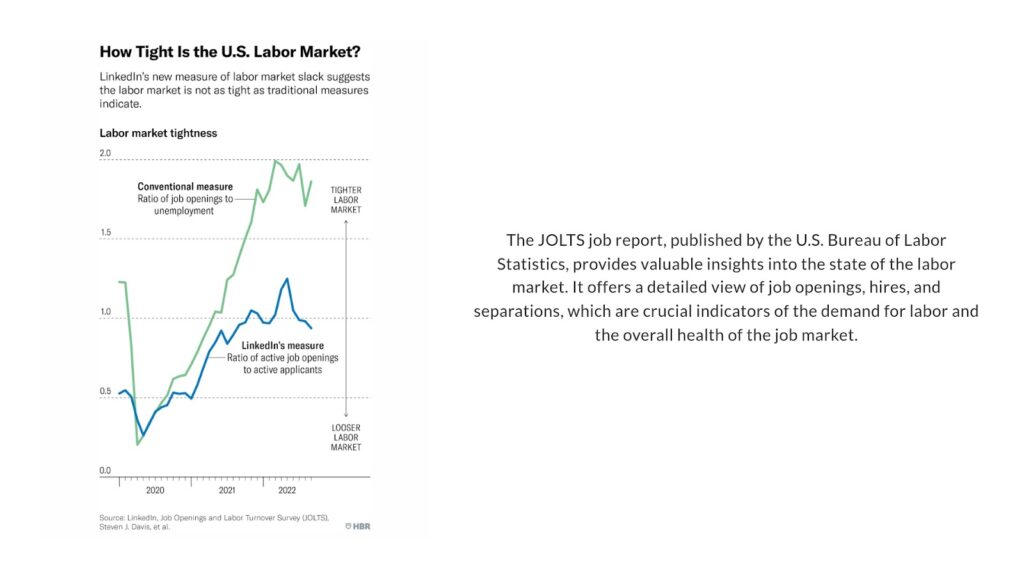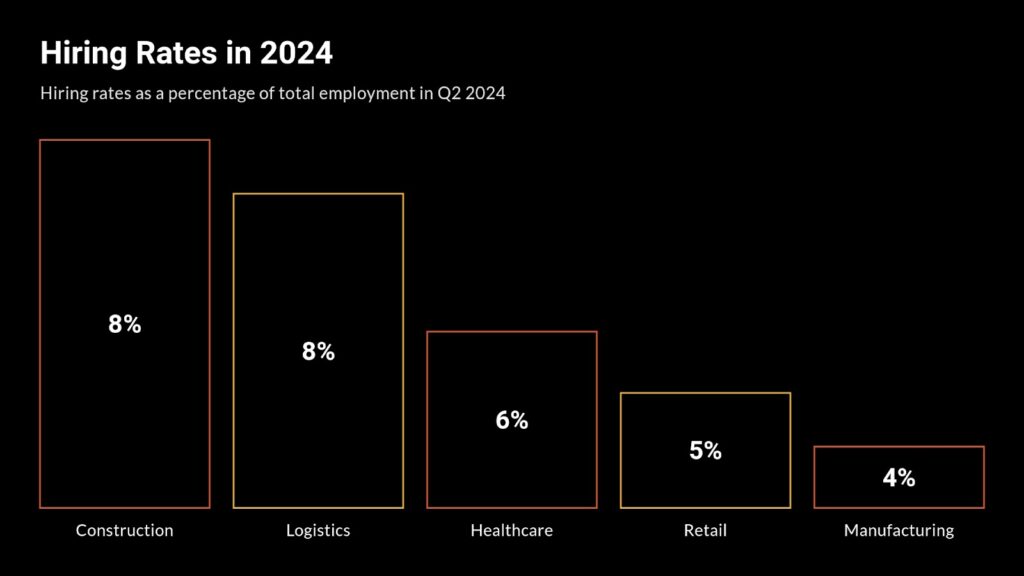In today’s rapidly shifting economic landscape, keeping a finger on the pulse of labor market trends is crucial for businesses, recruiters, and policymakers alike. One of the most critical tools for analyzing the dynamics of the job market in the U.S. is the JOLTS job report. Released by the U.S. Bureau of Labor Statistics, this report provides valuable insights into job openings, hires, separations, and overall market conditions.
In this article, we’ll explore why the JOLTS job report is essential for understanding the labor market, and how the latest data in 2024 can inform businesses and recruiters. We’ll also compare the JOLTS job report to other economic indicators, helping you draw broader insights into the U.S. economy. Finally, we’ll conclude with actionable steps for recruiters and HR professionals to leverage this data effectively.
What is the JOLTS Job Report?
The JOLTS job report stands for the Job Openings and Labor Turnover Survey, a monthly publication that captures vital statistics about the labor market. Specifically, the report provides information on:
- Job Openings: The number of positions that are available but unfilled on the last business day of the month.
- Hires: The total number of people hired during the month, including both new jobs and rehired employees.
- Separations: The number of employees who left their jobs during the month, which includes voluntary quits, layoffs, and discharges.
These metrics help paint a picture of the state of the U.S. job market, showing how many jobs are available, how often people are changing jobs, and whether employers are facing challenges in filling positions.
The importance of the JOLTS job report is particularly significant for businesses and policymakers. It provides insights into the demand for labor, the health of the job market, and potential mismatches between the skills employers need and the skills available in the workforce. By tracking changes in job openings, hires, and separations, businesses can make more informed decisions about hiring, compensation, and workforce planning.
Why Is the JOLTS Job Report Important?

In an economy where trends can change rapidly, the JOLTS job report provides a more detailed, real-time snapshot of the U.S. job market in 2024 than traditional employment reports, such as the monthly unemployment rate. It complements other economic indicators by showing not just how many people are unemployed but also how many job opportunities are available.
For example, a rising number of JOLTS job openings alongside stable or low unemployment could signal that employers are struggling to find workers with the right skills. On the other hand, if job openings are declining while separations are increasing, it may indicate that the labor market is cooling and that layoffs are on the rise.
In 2024, the JOLTS report today plays a crucial role in understanding the labor market because it provides a nuanced view of employment trends. Recruiters and HR professionals can use this information to understand broader trends and anticipate changes in the hiring landscape.
What the Latest JOLTS Data Reveals About the US Job Market?
As of the most recent data from the JOLTS job report in Q2 2024, several key trends have emerged:
- Job Openings
The number of JOLTS job openings in 2024 has shown a slight decrease compared to previous years. While job openings remain robust, indicating that businesses are still hiring, the pace of job creation has moderated. This could reflect broader economic uncertainties, with businesses taking a more cautious approach to expansion.
In sectors like technology and finance, job openings have contracted slightly, reflecting industry-specific challenges such as high-profile layoffs in tech companies. However, industries like healthcare and hospitality continue to see strong demand for workers. These sectors are experiencing labor shortages, with job openings outstripping available candidates, particularly in roles requiring specialized skills.
- Hires
Hiring rates, as indicated by the JOLTS job report, have also slowed down in some industries. This could be due to a combination of factors, including a tighter labor market and businesses becoming more selective in their hiring processes. Interestingly, sectors like construction and logistics are still experiencing relatively high hiring rates due to increased demand driven by infrastructure projects and e-commerce growth.

- Separations
The JOLTS report today reveals that separations, particularly voluntary quits, have decreased slightly from their peak levels during the “Great Resignation” period of 2021 and 2022. However, voluntary quits remain elevated in sectors like retail and hospitality, where workers continue to search for better opportunities or improved working conditions.
At the same time, layoffs and discharges have risen marginally, indicating some retrenchment in industries grappling with slower growth. This trend underscores the importance of economic conditions in shaping the labor market, as businesses reassess their workforce needs amid fluctuating demand.
How Can Businesses Use JOLTS Data to Improve Hiring Strategies?
The JOLTS job report offers valuable insights that businesses can use to refine their strategies. Here’s how:

1. Forecast Hiring Needs
For HR professionals and recruiters, understanding JOLTS job openings can help forecast future hiring needs. A surge in job openings in specific industries signals increased demand for talent, which may require businesses to ramp up recruitment efforts or rethink their compensation packages to stay competitive.
Conversely, a decline in job openings could indicate a slowdown, giving companies time to pause and evaluate their workforce strategy. For example, if job openings in your industry are declining, you may decide to focus more on retention and upskilling current employees rather than aggressively pursuing new hires.
2. Understand Labor Market Tightness
The JOLTS job report is also essential for understanding labor market tightness. When job openings exceed the number of unemployed individuals, it becomes a candidate-driven market, giving job seekers more negotiating power. In this scenario, businesses may need to adjust their hiring tactics by offering higher wages, better benefits, or more flexible working arrangements to attract top talent.
However, if the JOLTS data indicates fewer job openings and more separations, employers may have an easier time filling vacancies, but they should be cautious about over-hiring in a potentially slowing economy.
3. Assess Workforce Mobility
One of the unique insights from the JOLTS job report is the data on separations, particularly voluntary quits. High quit rates often suggest that workers are confident in their ability to find new jobs, which could mean they are leaving for better offers. Businesses experiencing high turnover can use this data to assess the competitiveness of their compensation and benefits packages, as well as to improve retention strategies.
How does the JOLTS Report Stack Up Against Other Economic Metrics?
While the JOLTS job report is a powerful tool for analyzing labor market trends, it’s essential to consider it in conjunction with other economic indicators. For instance, the Q2 2024 Economic Indicator Report highlights trends in GDP growth, inflation, and consumer spending—all of which can influence hiring and job market conditions.
- GDP Growth: If GDP growth is strong, businesses are likely to expand and create more jobs, leading to an increase in job openings. However, if GDP growth is sluggish, job creation may slow, and layoffs could rise.
- Inflation: Rising inflation can impact the labor market by eroding purchasing power and increasing costs for businesses. Companies may respond by slowing down hiring or focusing more on efficiency.
- Unemployment Rate: The unemployment rate, while a lagging indicator, complements the JOLTS job report by showing how many people are actively seeking work. When analyzed together, these two reports can offer a comprehensive view of the labor market’s health.
How Can Recruiters and HR Pros Leverage JOLTS Data?
Given the insights provided by the JOLTS job report and broader economic indicators, here are some actionable steps for recruiters and HR professionals in 2024:
- Focus on Workforce Planning: Use JOLTS data to anticipate shifts in labor market conditions. If job openings are rising in your industry, prepare for increased competition for talent by streamlining your recruitment processes and enhancing your employer brand.
- Enhance Retention Strategies: High quit rates may signal that your employees are looking for better opportunities elsewhere. Consider offering development programs, competitive pay, and flexible work arrangements to keep top performers engaged.
- Monitor Industry Trends: Use the JOLTS data to track industry-specific trends. If separations are high in your sector, it could indicate dissatisfaction among workers, providing an opportunity to address key pain points before they impact your workforce.
- Leverage Economic Data: Combine JOLTS insights with other economic reports, such as inflation and GDP growth, to gain a well-rounded understanding of market conditions. This can help you make informed decisions about hiring and compensation.
Conclusion
The JOLTS job report is an indispensable tool for understanding the U.S. job market in 2024. By analyzing trends in JOLTS job openings, hires, and separations, businesses and recruiters can make data-driven decisions about their workforce. In an evolving economic landscape, leveraging this data, alongside other indicators like GDP growth and inflation, can help businesses stay ahead of labor market trends.
For HR professionals and recruiters, the key to success in 2024 will be agility. Sign-up with JobsPikr to stay informed about the latest JOLTS data and adapting to shifts in the labor market, businesses can position themselves for growth, even in uncertain times.



